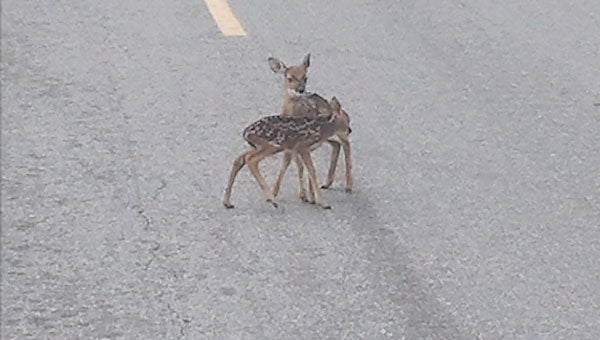Biologists urge caution when spotting young wildlife
Published 3:30 pm Friday, May 28, 2021

- Take caution when seeing young wildlife, like these fawn, without their parents. It might not be a drastic situation. (Photo from file)
|
Getting your Trinity Audio player ready...
|
RALEIGH – The biologists who staff the NC Wildlife Helpline at the N.C. Wildlife Resources Commission handle a glut of calls each spring and summer about fawns, bunnies and fledgling songbirds that people find and mistake as abandoned or in danger. Well-meaning people often put young wildlife into harm’s way when they intervene in a wild animal’s natural process of growing up
“In the majority of these cases, the mother is off feeding nearby and will return when no predators are nearby, and that includes people,” said Falyn Owens, extension biologist at the Wildlife Commission. “Most young animals spend a lot of time on their own, even before they appear able to fend for themselves. When the mother returns, sometimes many hours later, she expects to find her young near where she left them.”
Owens advises that if you truly feel the animal needs help, the best thing you can do is leave it alone (or put it back) and call a wildlife rehabilitator for advice.
Fawns
Deer use a “hider” strategy for the first two or three weeks of their life. At the doe’s signal, fawns instinctively find a quiet place to lay down and stay put. There they will usually stay stationary for several hours while the doe ventures away to feed. Fawns have a dappled coat and no scent, so they hide easily in the underbrush, making it difficult for predators such as coyotes and bobcats to find them.
If you find a fawn that is calm and appears uninjured, leave it be and check on it the next day. If it is still there and bleating loudly, appears thin, injured or has visible diarrhea, contact a licensed fawn rehabilitator for advice.
“If you remove a fawn from the wild but only a little time has passed, return it to where you found it,” Owens said. “A doe will usually try to find her missing fawn for about 48 hours before she gives up. After 48 hours, or if you have given the fawn any food, contact a fawn rehabilitator as soon as possible.”
Rabbits
Newborn rabbits spend their first few weeks hiding in plain sight, in shallow, dirt nests among clumps of thick grass, under shrubs, or in the middle of open lawns. Nests can be hard to spot, often resembling a small patch of dead grass. Like deer, the female rabbit will leave her kits alone most of the time, only visiting for a few minutes at a time, once or twice a day.
“We get a lot of calls from people who think they’ve found an abandoned nest of rabbits, when in fact the kits are just fine and quietly waiting for the mother rabbit to return,” Owens said. “If they appear to be healthy and unharmed, the best thing you can do is to cover up the nest and walk away. The mother will not return until you have left the area.”
Songbirds
Knowing the difference between a nestling and a fledgling can help you make the right decision if you see one on the ground. Nestlings don’t have their feathers yet and can’t survive outside of their nest for long. Fledglings have left the nest, have their feathers, and are able to walk, hop or fly short distances. They too are being cared for by the parents — but typically at a distance.
“If you find a nestling on the ground, return it to the nest as quickly as possible, if you’re able to find it,” Owens said. “If the entire nest has fallen, you can place it back in the tree, or even construct a makeshift nest.”
Fledglings, however, should be left alone in most cases. They have outgrown the nest and are learning how to fly and survive on their own. If they aren’t obviously injured or in any immediate danger, leave them to it. Like human toddlers, they need to explore to gain the muscles and coordination to become graceful adults. Keeping cats inside and dogs on leash are the best way to assure these young birds make it through this vulnerable learning stage.
Obey the Law
Leaving young wildlife alone is not only part of being a responsible steward of nature, but it is also the law.
“Taking most wild animals out of the wild and into your possession is illegal,” Owens said. “People usually mean well when they decide to help an ‘abandoned baby animal’, but this usually does more harm than good. The chances that a young wild animal will survive in human care are slim. Even those that live long enough to be released usually lack the skills to survive on their own.”
Owens stresses the importance of never feeding young wildlife, which can lead to irreversible harm to the animal.
“When in doubt, contact a professional before you do anything,” she advises. “Each spring, wildlife rehabilitators take in a lot of young that are malnourished, have severe bowel distress from being given the wrong foods, or are injured from improper feeding.”
And don’t worry if you touch a fawn, immature rabbit, or bird. Wild parents almost never abandon their young, even if they detect human scent.





